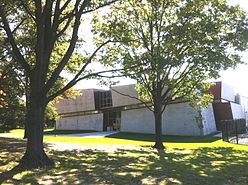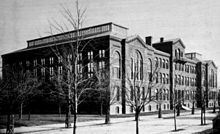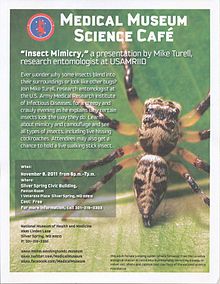- National Museum of Health and Medicine
-
National Museum of Health and Medicine (founded as the Army Medical Museum) 
The exterior of the new National Museum of Health and Medicine which opened at its new location on September 15, 2011.General information Location 2500 Linden Lane, Silver Spring, Maryland The National Museum of Health and Medicine (NMHM) is a museum in Silver Spring, Maryland, near Washington, D.C., USA.[1] An element of the Armed Forces Institute of Pathology[1](AFIP), the NMHM is a member of the National Health Sciences Consortium.[2]
The museum was founded by U.S. Army Surgeon General William A. Hammond as the Army Medical Museum (AMM) in 1862[3]; it became the NMHM in 1989.[4]
Contents
History
 The Army Medical Museum and Library building housed the Army Medical Museum beginning in 1887.
The Army Medical Museum and Library building housed the Army Medical Museum beginning in 1887.
19th century
The AMM was established during the American Civil War[4] as a center for the collection of specimens for research in military medicine and surgery.[5] In 1862, Hammond directed medical officers in the field to collect "specimens of morbid anatomy ... together with projectiles and foreign bodies removed"[5] and to forward them to the newly founded museum for study. The AMM's first curator, John H. Brinton, visited mid-Atlantic battlefields and solicited contributions from doctors throughout the Union Army. During and after the war, AMM staff took pictures of wounded soldiers showing effects of gunshot wounds as well as results of amputations and other surgical procedures. The information collected was compiled into six volumes of The Medical and Surgical History of the War of the Rebellion, published between 1870 and 1883.[5]
20th century
During the late 19th and early 20th centuries, AMM staff engaged in various types of medical research. They pioneered in photomicrographic techniques, established a library and cataloging system which later formed the basis for the National Library of Medicine (NLM), and led the AMM into research on infectious diseases while discovering the cause of yellow fever. They contributed to research on vaccinations for typhoid fever, and during World War I, AMM staff were involved in vaccinations and health education campaigns, including major efforts to combat sexually transmissible diseases.[5]
By World War II, research at the AMM focused increasingly on pathology. In 1946 the AMM became a division of the new Army Institute of Pathology (AIP), which became the Armed Forces Institute of Pathology (AFIP) in 1949. The AMM's library and part of its archives were transferred to the National Library of Medicine when it was created in 1956. The AMM itself became the Medical Museum of the AFIP in 1949, the Armed Forces Medical Museum in 1974, and finally the NMHM in 1989.[5]
2011 Move
Due to the closure of WRAMC, NMHM relocated to US Army Garrison-Forest Glen in Silver Spring, Montgomery County, Maryland.[6] Authority over the Forest Glen garrison was transferred from WRAMC to Fort Detrick in October 2008. The NMHM closed its exhibits on April 3, 2011, and reopened on September 15, 2011.
Holdings
Major Collections
The NMHM embodies five collections consisting of about 25 million artifacts, including 5,000 skeletal specimens, 8,000 preserved organs[7], 12,000 items of medical equipment, an archive of historic medical documents, and collections related to neuroanatomy and developmental anatomy. The museum's most famous artifacts relate to President Abraham Lincoln and his assassination on April 14, 1865[8] by John Wilkes Booth. On display are a copy by sculptor Avarel Fairbanks of Lincoln's life mask and hands made by Leonard Volk in 1860, the bullet fired from the Deringer pistol which ended the President's life, the probe used by the US Army Surgeon General to locate the bullet during autopsy, pieces of Lincoln's hair and skull, and the autopsy surgeon's shirt cuff, stained with Lincoln's blood.[9]
Museum collections include:
- The Historical Collections document changes in medical technology since the early 19th century. Included in this growing assemblage of more than 12,000 objects are x-ray equipment, microscopes, surgical instruments, numismatics and anatomical models.
- The Anatomical Collections are made up of bones and body parts. More than 5,000 skeletal specimens and 10,000 preserved organs document medical cases of disease and injury. The collection supports research in pathology, physical anthropology, forensic anthropology, and paleopathology.
- The Otis Historical Archives houses photographs, illustrations, and documents related to health and medicine. More than 350 different collections document, in pictures and words, the practice of medicine from the Civil War to the present.
- The Human Developmental Anatomy Center maintains the largest collection of embryologic material in the United States. The Center is a primary source for centralized research in developmental anatomy. The Center is also known for its imaging and 3-D reconstructions of embryo development.
- The Neuroanatomical Collections comprise nine different collections focusing on human and non-human neuroanatomy and neuropathology. These collections are a unique international resource for the study of the brain.
Major Exhibitions
Museum exhibitions feature several permanent exhibits alongside several rotating displays.
- To Bind Up the Nation's Wounds: Medicine During the Civil War shows Civil War medicine through the eyes of battlefield surgeons and the stories of Union and Confederate sick and wounded.
- Evolution of the Microscope displays items from the world's largest and most representative collection in tracing the development of the basic tool of the bioscientist over the last 400 years.
- Battlefield Surgery 101: From the Civil War to Vietnam, drawn exclusively from the museum's historical archives and historical collections, presents the highlights of the evolution of military surgical activities over the last 140 years through a selection of photographs and 19th- and 20th- century artifacts.
- Abraham Lincoln: The Final Casualty of the War: To mark the 200th anniversary of President Abraham Lincoln's birth, NMHM honors our 16th president with this exhibition of items associated with his last hours and the physicians who cared for him.
- Trauma Bay II, Balad, Iraq offers a rare view inside a former Air Force tent hospital in Balad, Iraq.
- RESOLVED: Advances in Forensic Identification of U.S. War Dead highlights the underlying forensic sciences that have evolved in fulfilling this nation’s commitment to the identification and commemoration of the U.S. service member.
Programs Offered
The museum offers a wide variety of programs on weekends, weekdays, and evenings throughout the year for adults and children, with topics ranging through a spectrum of medical, scientific, and historical subjects.[10]
Other exhibit information is available here.
Location and hours
The museum is located at 2500 Linden Lane in Silver Spring, Maryland, just a few miles outside the District of Columbia. It is open to the public, but security restrictions require a photo ID for all adult visitors.[11] It is open from 10 a.m. to 5:30 p.m. every day except Christmas (when it is closed), and admission is free.[12]
See also
References
- ^ a b http://www.nlm.nih.gov/hmd/medtour/nmhm.html
- ^ http://www.city-data.com/articles/National-Museum-of-Health-Medicine.html
- ^ http://www.whonamedit.com/doctor.cfm/542.html
- ^ a b http://nmhm.washingtondc.museum/about/faq/index.html#2.1
- ^ a b c d e http://nmhm.washingtondc.museum/about/about.html
- ^ Palk, Justin M. (2008), “Fort Detrick to take over Forest Glen”, FrederickNewsPost.com, 7 October 2008.
- ^ http://nmhm.washingtondc.museum/about/faq/index.html#5.3
- ^ http://nmhm.washingtondc.museum/exhibits/nationswounds/lincoln.html
- ^ http://nmhm.washingtondc.museum/exhibits/exhibits.html#indefinitely
- ^ National Museum of Health and Medicine Events, http://nmhm.washingtondc.museum/events/event_2ed.html, accessed 7 Oct 2011.
- ^ http://www.yelp.com/biz/national-museum-of-health-and-medicine-washington
- ^ http://nmhm.washingtondc.museum/about/faq/index.html#1.4
External links
- The National Museum of Health and Medicine official website
- BrainMuseum.org - a partnership of the University of Wisconsin and Michigan State Comparative Mammalian Brain Collections and the National Museum of Health and Medicine
- James G. Mundie's photographs from The National Museum of Health and Medicine
U.S. National Register of Historic Places Topics Lists by states Alabama • Alaska • Arizona • Arkansas • California • Colorado • Connecticut • Delaware • Florida • Georgia • Hawaii • Idaho • Illinois • Indiana • Iowa • Kansas • Kentucky • Louisiana • Maine • Maryland • Massachusetts • Michigan • Minnesota • Mississippi • Missouri • Montana • Nebraska • Nevada • New Hampshire • New Jersey • New Mexico • New York • North Carolina • North Dakota • Ohio • Oklahoma • Oregon • Pennsylvania • Rhode Island • South Carolina • South Dakota • Tennessee • Texas • Utah • Vermont • Virginia • Washington • West Virginia • Wisconsin • WyomingLists by territories Lists by associated states Other Categories:- Museums established in 1862
- Medical museums in the United States
- Science museums in Washington, D.C.
- Military and war museums in Washington, D.C.
- Military medicine in the United States
- American national museums in Washington, D.C.
Wikimedia Foundation. 2010.


